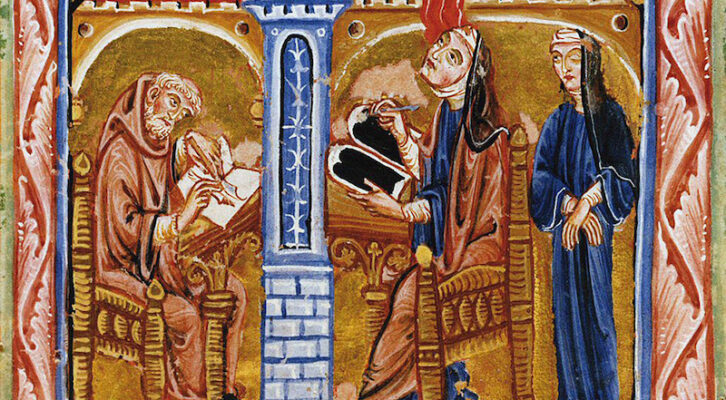
The Brave Women Who Saved the Collected Texts of Hildegard of Bingen
Janina Ramirez on the Rescue of a Priceless Manuscript in Post-War Germany
11 March 1948 – Eibingen Monastery, Wiesbaden, Germany
A brave, frightened women is risking her life in a daring rescue mission. In these post-war years, medieval scholar Margarete Kühn is not dealing with spies and Nazis: instead, she has kidnapped a book. Assisted by her friend Caroline Walsh, an American military spouse, Margarete has secured the manuscript’s safe passage across 400 miles, traversing the wildest and most hostile parts of Germany’s war-ravaged landscape to a secluded monastery high above the banks of the Rhine.
As well as saving the precious reams of vellum, the women are preserving something more important still: the legacy of a twelfth-century saint whose reputation is second to none in Germany. From her childhood as an enclosed nun with just a handful of companions, to her rise on the international stage as a leading scholar, theologian, visionary, musician, linguist, artist and scientist, the remarkable life of Hildegard of Bingen (1098– 1179) has been celebrated for centuries. Yet as the aftermath of the Second World War rips through her home in the Rhineland, her written works are destroyed, stolen, hidden and lost. This is a post-war thriller with a medieval twist.
Climbing the cobbled slope alone towards the imposing gates of Eibingen Abbey, Caroline Walsh knows she is doing something extremely dangerous. Her marital connections to the US air force, along with Margarete’s months of preparation, has allowed her to move across the recently partitioned Soviet and American sectors of Germany with 15 kilograms of priceless manuscript concealed on her person. Germany’s defeat in the war has resulted in the dramatic division of the country into areas under the control of French, British, Soviet and American troops, with Berlin also divided between the allied powers.
Margarete lives in the American sector of West Berlin, but she travels to the Soviet East for her job working on a huge project to collate all primary German texts from the Romans to AD 1500, called the Monumenta Germaniae Historica. Her involvement in the reckless mission to save Hildegard’s book will make all future crossings a fraught experience, full of the fear of detection, incarceration or worse; because Margarete has deceived the Russian authorities. Catherine too has risked arrest by bringing the manuscript via train and car to the nuns of Hildegard. But as she watches the abbess of Eibingen clasp the enormous manuscripts to her chest, she knows that Hildegard’s work is home. The risk was worth it.
The manuscript is priceless. Known as the Riesencodex (‘the giant book’) because of its size, it is made up of 481 folios of vellum held together by wooden boards bound in pig leather that measure 45 centimetres by 30 centimetres. Still attached to its spine is a chain, originally used to secure it to the library of the monastery Hildegard founded in Rupertsberg (today called Bingen). The book contains almost all her writings; a rare attempt to create a single version of her “definitive works” while she was still alive. Many scribes worked for years to collect her visions, music, linguistic writings, homilies, biography and letters. Very few writers even now are so popular in their lifetimes to have such a volume made in their honor.
The manuscript was compiled towards the end of her life, circa 1179, at Rupertsberg. The story of its rescue revolves around a second monastery founded by Hildegard—the site at Eibingen. But many of the texts it contains were originally composed at the monastery where she spent the first decades of her life—Disibodenberg. These three sites form the basis of the “Hildegard Way” through the heart of the Rhineland, which devoted pilgrims can still travel today to get close to the woman and her works.
The Riesencodex had been on the run before. During the Thirty Years War (1618–48) when Swedish troops looted Hildegard’s monastery of Rupertsberg, its nuns escaped with the book, carried it across the Rhine and hid it at their sister house of Eibingen. Two hundred years later, when religious establishments in Germany were secularized and their property taken in 1814, the manuscript went on another short trip 35 kilometres along the river to the newly founded State Library of Wiesbaden. Until the start of the Second World War, the Riesencodex stayed firmly in and around the Rhineland-Palatine where Hildegard herself spent her 81 years.
But under the threat of bombing raids, library director Gustav Struck sent it on a long journey to Dresden, hundreds of miles east, along with a set of eight books that also needed safekeeping. The Riesencodex was travelling with another of Hildegard’s most precious manuscripts, a priceless copy of her major work Scivias, containing illuminations that Hildegard herself had a hand in. An insurance report at the time states that: “the total value of the manuscripts housed in Dresden should amount to at least five million Reichsmarks. A replacement is completely impossible since all of them are one-offs.”
Fate was not on the side of Gustav Struck. His assurance from Nazi advisers that Dresden was safer than Wiesbaden was devastatingly inaccurate. In February 1945 the beautiful city was hammered by Allied bombs, killing thousands and flattening buildings. Remarkably, the bank vault containing Hildegard’s manuscripts survived, but when officials arrived to examine its holdings they discovered that it had been pillaged.
The only manuscript still in the vault was the Riesencodex, probably because it was partly hidden and its custom-made metal box was so heavy. In accordance with Soviet instructions to collect first-class artefacts found in Russian-held German territories, the Riesencodex became the property of the state. Scholars and Hildegard devotees across the world were anxious that they would never again be able to freely consult her collected works. They needed a plan and Margarete would prove to be the linchpin.
Margarete was not the mastermind behind the plan to save the tome. Hers was the fourth attempt to take Hildegard’s work out of Soviet hands. The new director of the Wiesbaden State Library, Franz Götting, had tried every possible legal means of having the manuscript returned, but each was unsuccessful.
By 1948 he and Margarete had decided that the Riesencodex should be removed from war-torn Dresden by any means and reunited with the community of nuns who continue to sing, read, research and live by Hildegard’s example. A plot was forged; Margarete’s position on the Monumenta Germaniae Historica project in the Soviet sector of Berlin meant she could request access to the manuscript and it would be sent for from Dresden. But this was not just an academic mission for Margarete; it was also personal.
Letters have recently been discovered which show that Margarete wanted to join the nuns at Eibingen. The modern-day monastery can be seen from miles away, its twentieth-century gothic-style towers looming over a colorful landscape of vineyards, with the Rhine twinkling brightly below. It is a beautiful site and Margarete would have known what comforts awaited her. Not only could she have pursued her devotion to medieval scholarship in the monastery’s enviable library, but she would follow the Benedictine Rule and fill her days with meaningful work.
Whether producing wine, creating ceramic art, crafting gold or simply tending to the needs of the many nuns in Eibingen, she would have kept busy. Throughout the day and night her life would be punctuated with the routine of the monastic hours, which she would recite alongside her sisters in the stunning abbey church. Paintings from the famous Beuronese art school would tower above her, presenting iconic, timeless women more reminiscent of Byzantine times than twentieth-century Germany. These would be constant reminders that great things had been achieved by her female forebears.
Becoming a nun at Eibingen must have seemed an attractive idea to the lonely and pious Margarete. Devastated by the death of her brother and bewildered by the changes afflicting wartime Germany, in 1946 she visited the abbey to discuss whether she might become a novice. The nuns, however, were unconvinced she was ready for monastic enclosure. Instead, with Gotting’s help they set her a very worldly mission—to use her connections as a medievalist to rescue Hildegard’s works.
Against all the odds, Margarete persuaded the Soviet authorities to lend her the manuscript to photograph it. Unable to believe her luck, she set about capturing images of the precious manuscript for future generations. And as soon as she had completed the task, she began plotting how to get the book to Eibingen. It weighed the same as a French bulldog and was protected property of the Russian state. The plan with Caroline was hatched and, after a period of nervous preparation and tense execution, the Riesencodex was finally making its way to Eibingen. Margarete’s one regret was that, after all her efforts, she couldn’t be the woman to hand it over. This honour fell to Caroline.
With the goal achieved, however, how would Margarete throw the authorities off the scent? It was Marianne Schrader, a nun at Eibingen, who was to propose something rather underhand. She asked Götting, the library director in Wiesbaden, if he could find a book of the same size and weight as the Riesencodex, the idea being that the fake would be returned while the original was held in Eibingen. Selecting a fifteenth-century printed book of similar dimensions, Götting attached a chain to it and sealed it back in the box in which it had been delivered. It wasn’t until Soviet authorities opened it in 1950 that the fraud was detected.
The revelation put Margarete in grave danger, and her supporters had to hatch another plan to protect her. She had needed surgery to remove a cancerous eye, so Götting told the furious Soviets that Margarete’s poor eyesight meant she mistook the book and returned the wrong one. Götting was unflinching in his support of Margarete, and a compromise was finally agreed. If other valuable books were given to Dresden, Wiesbaden could keep the Riesencodex. After a sojourn with the nuns, the manuscript returned to the state library in Wiesbaden, where it still resides today.
Margarete Kühn’s involvement in saving the manuscript is little known. She quietly continued to contribute to medieval scholarship and outlived all her colleagues, dying 40 years after these events at the age of 92. Her obituary describes how she lived “an almost monastic existence,” something she clearly craved. She is an unsung hero of the dark post-war chapter of European history, from which numerous artworks and precious documents of the past may never emerge. Thanks to Margarete, this manuscript made it out, but its companion—Hildegard’s Scivias, complete with the famous illuminations of Hildegard’s visions—is still untraceable.
Fortunately, reproductions were made of the images before the manuscript was lost, but the original could still be out there, in a private collection or gathering dust in an attic. Perhaps on reading this, someone somewhere might make it public. For now, though, all is not lost. Margarete and Catherine’s dedication—their willingness to put their life on the line for Hildegard—has meant her reputation as a medieval wonder woman continues to spread.
_______________________________

From Femina: A New History of the Middle Ages, Through the Women Written Out of It by Janina Ramirez © 2023 by Janina Ramirez, used with permission from HarperCollins/Hanover Square Press.
Janina Ramirez
Dr. Janina Ramirez is an Oxford lecturer, BBC broadcaster, researcher and author. She has presented and written over thirty hours of BBC history documentaries and series on TV and radio, and written five books for children and adults.



















